Analyzing Tesco's EDI Issues: A Leadership and Management Case Study
VerifiedAdded on 2023/06/17
|8
|1435
|199
Case Study
AI Summary
This case study examines the equality, diversity, and inclusion (EDI) challenges faced by Tesco, particularly concerning gender-based pay inequalities. It discusses the legal claims against Tesco, where female employees alleged being paid less than their male counterparts for equivalent work. The analysis involves applying motivational and diverse management theories, such as Maslow's hierarchy of needs and Herzberg's two-factor theory, to assess Tesco's human resource strategies. The case explores what Tesco could have done differently to avoid the problem, including adhering to the Equality Act of 2010, and evaluates the effectiveness of their responses. It also considers strategies for managing diversity and the impact of the crisis on Tesco's reputation and leadership, emphasizing the need for transparent communication and ethical conduct. Desklib provides access to similar solved assignments and case studies for students.
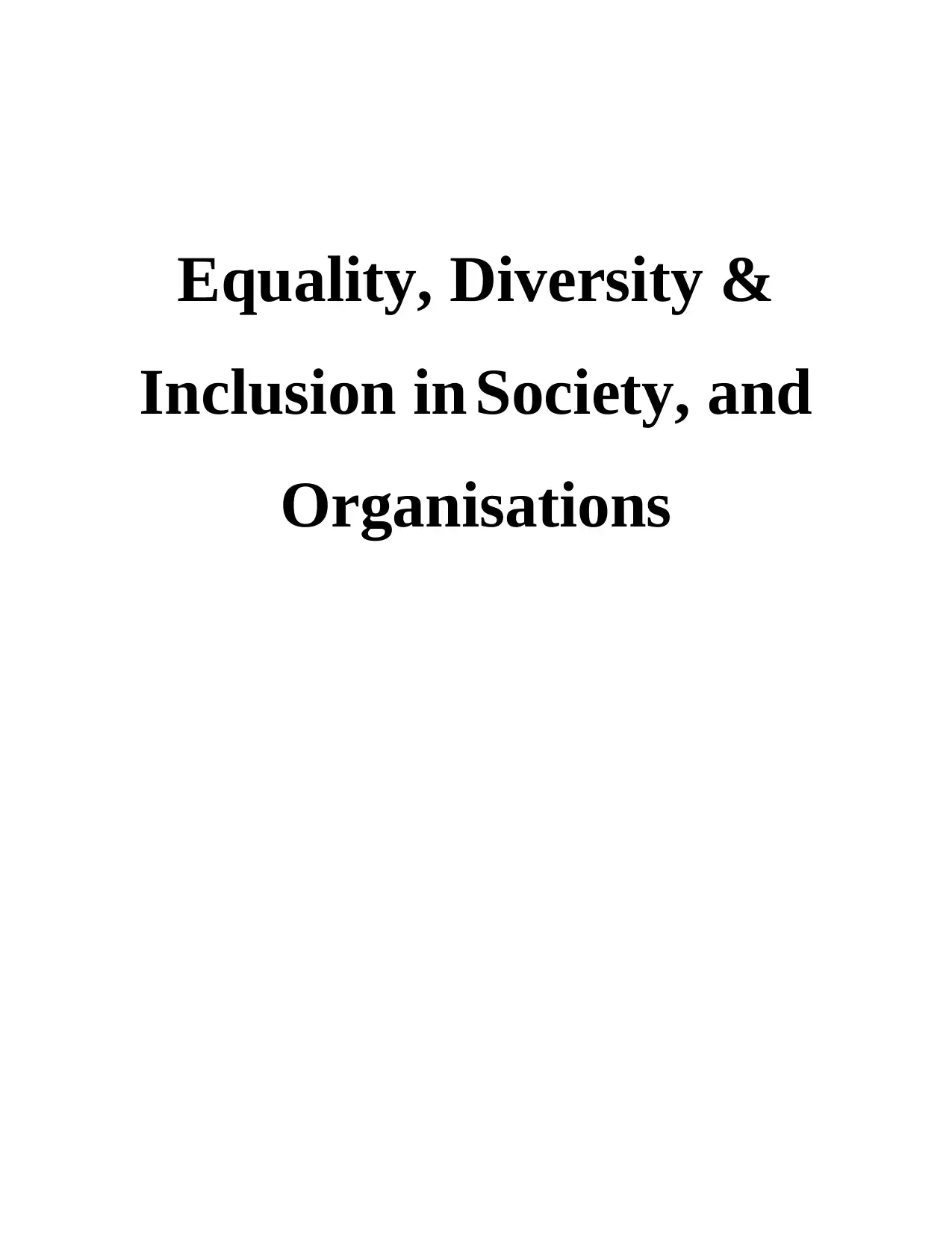
Equality, Diversity &
Inclusion in Society, and
Organisations
Inclusion in Society, and
Organisations
Paraphrase This Document
Need a fresh take? Get an instant paraphrase of this document with our AI Paraphraser

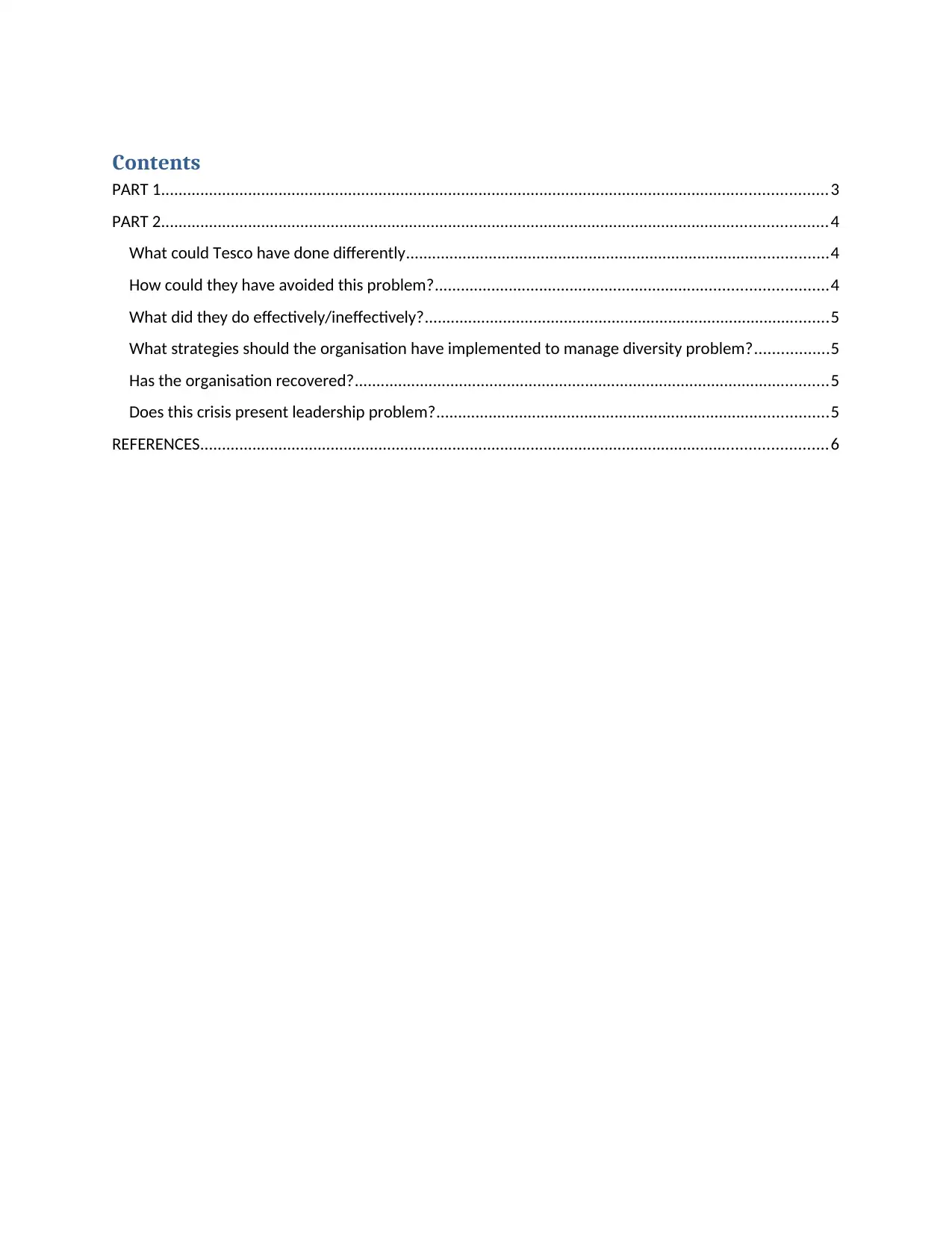
Contents
PART 1.........................................................................................................................................................3
PART 2.........................................................................................................................................................4
What could Tesco have done differently.................................................................................................4
How could they have avoided this problem?..........................................................................................4
What did they do effectively/ineffectively?.............................................................................................5
What strategies should the organisation have implemented to manage diversity problem?.................5
Has the organisation recovered?.............................................................................................................5
Does this crisis present leadership problem?..........................................................................................5
REFERENCES................................................................................................................................................6
PART 1.........................................................................................................................................................3
PART 2.........................................................................................................................................................4
What could Tesco have done differently.................................................................................................4
How could they have avoided this problem?..........................................................................................4
What did they do effectively/ineffectively?.............................................................................................5
What strategies should the organisation have implemented to manage diversity problem?.................5
Has the organisation recovered?.............................................................................................................5
Does this crisis present leadership problem?..........................................................................................5
REFERENCES................................................................................................................................................6
⊘ This is a preview!⊘
Do you want full access?
Subscribe today to unlock all pages.

Trusted by 1+ million students worldwide
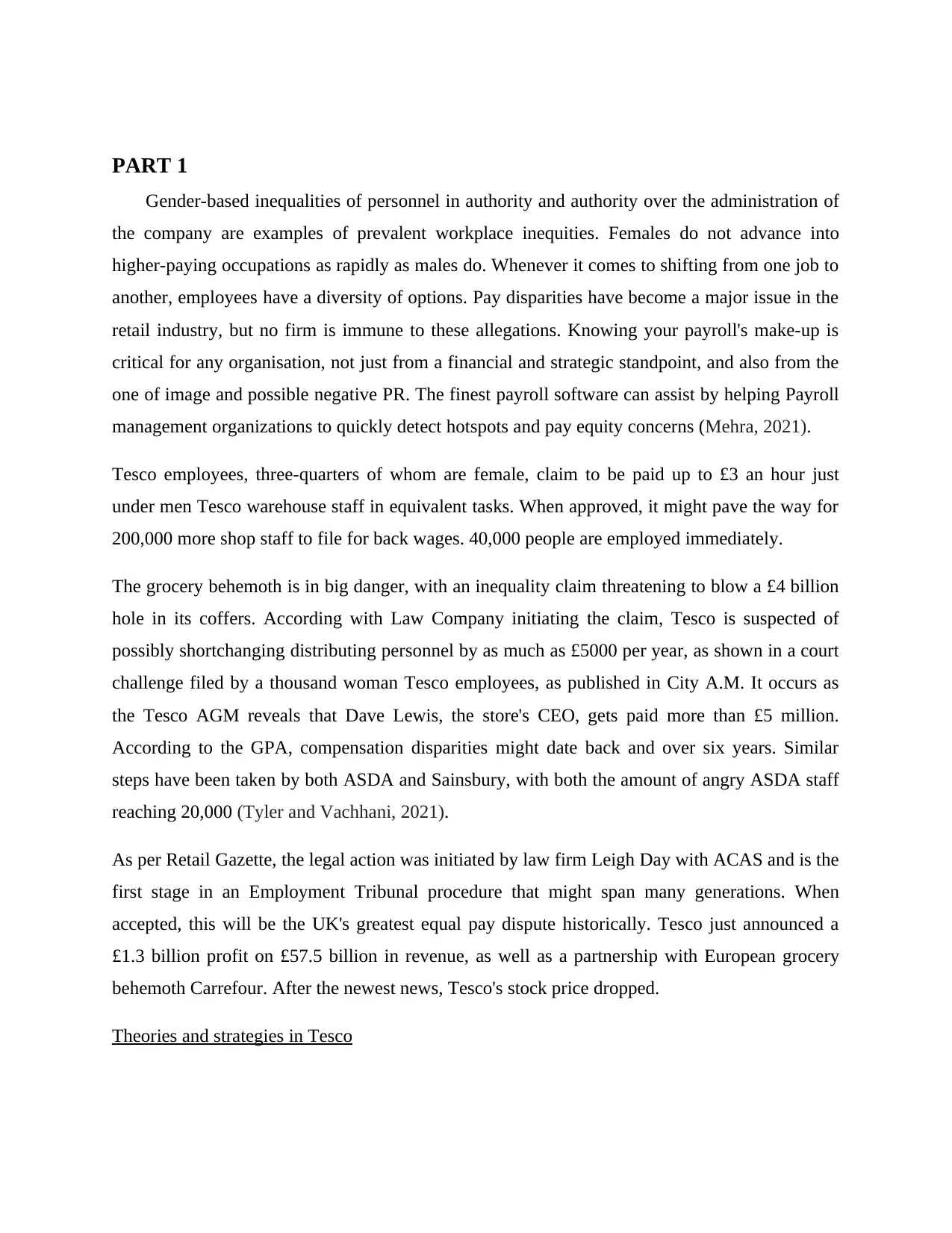
PART 1
Gender-based inequalities of personnel in authority and authority over the administration of
the company are examples of prevalent workplace inequities. Females do not advance into
higher-paying occupations as rapidly as males do. Whenever it comes to shifting from one job to
another, employees have a diversity of options. Pay disparities have become a major issue in the
retail industry, but no firm is immune to these allegations. Knowing your payroll's make-up is
critical for any organisation, not just from a financial and strategic standpoint, and also from the
one of image and possible negative PR. The finest payroll software can assist by helping Payroll
management organizations to quickly detect hotspots and pay equity concerns (Mehra, 2021).
Tesco employees, three-quarters of whom are female, claim to be paid up to £3 an hour just
under men Tesco warehouse staff in equivalent tasks. When approved, it might pave the way for
200,000 more shop staff to file for back wages. 40,000 people are employed immediately.
The grocery behemoth is in big danger, with an inequality claim threatening to blow a £4 billion
hole in its coffers. According with Law Company initiating the claim, Tesco is suspected of
possibly shortchanging distributing personnel by as much as £5000 per year, as shown in a court
challenge filed by a thousand woman Tesco employees, as published in City A.M. It occurs as
the Tesco AGM reveals that Dave Lewis, the store's CEO, gets paid more than £5 million.
According to the GPA, compensation disparities might date back and over six years. Similar
steps have been taken by both ASDA and Sainsbury, with both the amount of angry ASDA staff
reaching 20,000 (Tyler and Vachhani, 2021).
As per Retail Gazette, the legal action was initiated by law firm Leigh Day with ACAS and is the
first stage in an Employment Tribunal procedure that might span many generations. When
accepted, this will be the UK's greatest equal pay dispute historically. Tesco just announced a
£1.3 billion profit on £57.5 billion in revenue, as well as a partnership with European grocery
behemoth Carrefour. After the newest news, Tesco's stock price dropped.
Theories and strategies in Tesco
Gender-based inequalities of personnel in authority and authority over the administration of
the company are examples of prevalent workplace inequities. Females do not advance into
higher-paying occupations as rapidly as males do. Whenever it comes to shifting from one job to
another, employees have a diversity of options. Pay disparities have become a major issue in the
retail industry, but no firm is immune to these allegations. Knowing your payroll's make-up is
critical for any organisation, not just from a financial and strategic standpoint, and also from the
one of image and possible negative PR. The finest payroll software can assist by helping Payroll
management organizations to quickly detect hotspots and pay equity concerns (Mehra, 2021).
Tesco employees, three-quarters of whom are female, claim to be paid up to £3 an hour just
under men Tesco warehouse staff in equivalent tasks. When approved, it might pave the way for
200,000 more shop staff to file for back wages. 40,000 people are employed immediately.
The grocery behemoth is in big danger, with an inequality claim threatening to blow a £4 billion
hole in its coffers. According with Law Company initiating the claim, Tesco is suspected of
possibly shortchanging distributing personnel by as much as £5000 per year, as shown in a court
challenge filed by a thousand woman Tesco employees, as published in City A.M. It occurs as
the Tesco AGM reveals that Dave Lewis, the store's CEO, gets paid more than £5 million.
According to the GPA, compensation disparities might date back and over six years. Similar
steps have been taken by both ASDA and Sainsbury, with both the amount of angry ASDA staff
reaching 20,000 (Tyler and Vachhani, 2021).
As per Retail Gazette, the legal action was initiated by law firm Leigh Day with ACAS and is the
first stage in an Employment Tribunal procedure that might span many generations. When
accepted, this will be the UK's greatest equal pay dispute historically. Tesco just announced a
£1.3 billion profit on £57.5 billion in revenue, as well as a partnership with European grocery
behemoth Carrefour. After the newest news, Tesco's stock price dropped.
Theories and strategies in Tesco
Paraphrase This Document
Need a fresh take? Get an instant paraphrase of this document with our AI Paraphraser
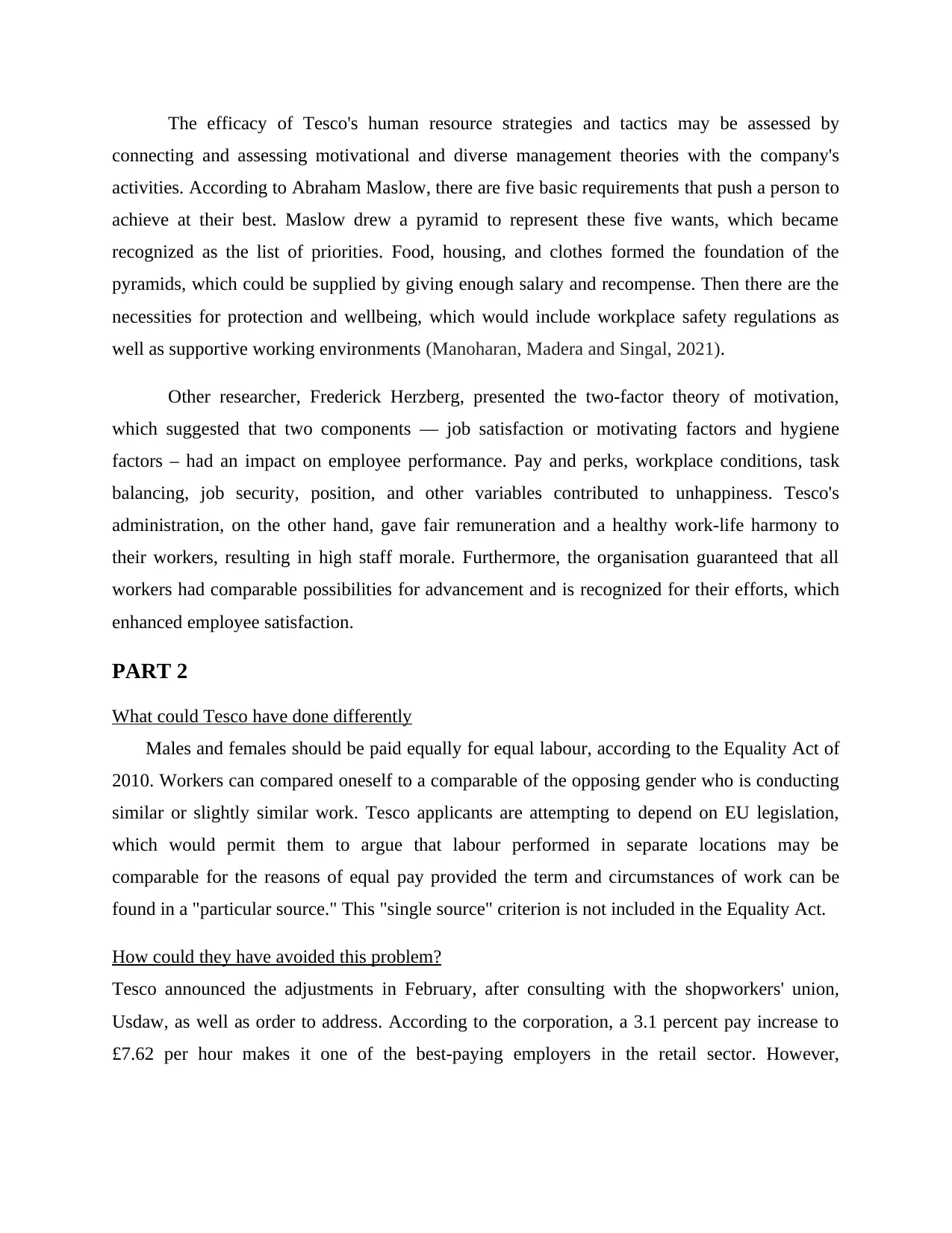
The efficacy of Tesco's human resource strategies and tactics may be assessed by
connecting and assessing motivational and diverse management theories with the company's
activities. According to Abraham Maslow, there are five basic requirements that push a person to
achieve at their best. Maslow drew a pyramid to represent these five wants, which became
recognized as the list of priorities. Food, housing, and clothes formed the foundation of the
pyramids, which could be supplied by giving enough salary and recompense. Then there are the
necessities for protection and wellbeing, which would include workplace safety regulations as
well as supportive working environments (Manoharan, Madera and Singal, 2021).
Other researcher, Frederick Herzberg, presented the two-factor theory of motivation,
which suggested that two components — job satisfaction or motivating factors and hygiene
factors – had an impact on employee performance. Pay and perks, workplace conditions, task
balancing, job security, position, and other variables contributed to unhappiness. Tesco's
administration, on the other hand, gave fair remuneration and a healthy work-life harmony to
their workers, resulting in high staff morale. Furthermore, the organisation guaranteed that all
workers had comparable possibilities for advancement and is recognized for their efforts, which
enhanced employee satisfaction.
PART 2
What could Tesco have done differently
Males and females should be paid equally for equal labour, according to the Equality Act of
2010. Workers can compared oneself to a comparable of the opposing gender who is conducting
similar or slightly similar work. Tesco applicants are attempting to depend on EU legislation,
which would permit them to argue that labour performed in separate locations may be
comparable for the reasons of equal pay provided the term and circumstances of work can be
found in a "particular source." This "single source" criterion is not included in the Equality Act.
How could they have avoided this problem?
Tesco announced the adjustments in February, after consulting with the shopworkers' union,
Usdaw, as well as order to address. According to the corporation, a 3.1 percent pay increase to
£7.62 per hour makes it one of the best-paying employers in the retail sector. However,
connecting and assessing motivational and diverse management theories with the company's
activities. According to Abraham Maslow, there are five basic requirements that push a person to
achieve at their best. Maslow drew a pyramid to represent these five wants, which became
recognized as the list of priorities. Food, housing, and clothes formed the foundation of the
pyramids, which could be supplied by giving enough salary and recompense. Then there are the
necessities for protection and wellbeing, which would include workplace safety regulations as
well as supportive working environments (Manoharan, Madera and Singal, 2021).
Other researcher, Frederick Herzberg, presented the two-factor theory of motivation,
which suggested that two components — job satisfaction or motivating factors and hygiene
factors – had an impact on employee performance. Pay and perks, workplace conditions, task
balancing, job security, position, and other variables contributed to unhappiness. Tesco's
administration, on the other hand, gave fair remuneration and a healthy work-life harmony to
their workers, resulting in high staff morale. Furthermore, the organisation guaranteed that all
workers had comparable possibilities for advancement and is recognized for their efforts, which
enhanced employee satisfaction.
PART 2
What could Tesco have done differently
Males and females should be paid equally for equal labour, according to the Equality Act of
2010. Workers can compared oneself to a comparable of the opposing gender who is conducting
similar or slightly similar work. Tesco applicants are attempting to depend on EU legislation,
which would permit them to argue that labour performed in separate locations may be
comparable for the reasons of equal pay provided the term and circumstances of work can be
found in a "particular source." This "single source" criterion is not included in the Equality Act.
How could they have avoided this problem?
Tesco announced the adjustments in February, after consulting with the shopworkers' union,
Usdaw, as well as order to address. According to the corporation, a 3.1 percent pay increase to
£7.62 per hour makes it one of the best-paying employers in the retail sector. However,
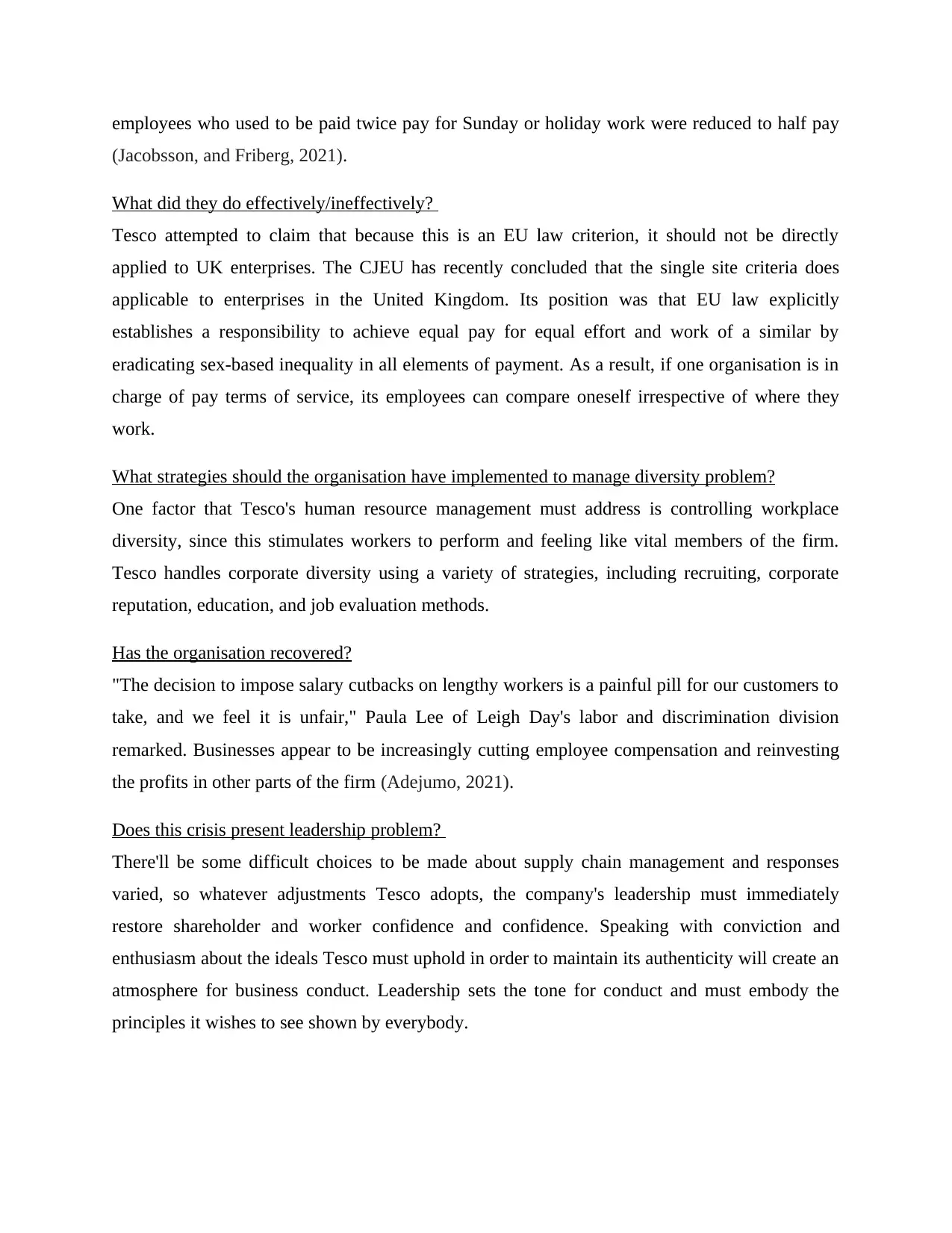
employees who used to be paid twice pay for Sunday or holiday work were reduced to half pay
(Jacobsson, and Friberg, 2021).
What did they do effectively/ineffectively?
Tesco attempted to claim that because this is an EU law criterion, it should not be directly
applied to UK enterprises. The CJEU has recently concluded that the single site criteria does
applicable to enterprises in the United Kingdom. Its position was that EU law explicitly
establishes a responsibility to achieve equal pay for equal effort and work of a similar by
eradicating sex-based inequality in all elements of payment. As a result, if one organisation is in
charge of pay terms of service, its employees can compare oneself irrespective of where they
work.
What strategies should the organisation have implemented to manage diversity problem?
One factor that Tesco's human resource management must address is controlling workplace
diversity, since this stimulates workers to perform and feeling like vital members of the firm.
Tesco handles corporate diversity using a variety of strategies, including recruiting, corporate
reputation, education, and job evaluation methods.
Has the organisation recovered?
"The decision to impose salary cutbacks on lengthy workers is a painful pill for our customers to
take, and we feel it is unfair," Paula Lee of Leigh Day's labor and discrimination division
remarked. Businesses appear to be increasingly cutting employee compensation and reinvesting
the profits in other parts of the firm (Adejumo, 2021).
Does this crisis present leadership problem?
There'll be some difficult choices to be made about supply chain management and responses
varied, so whatever adjustments Tesco adopts, the company's leadership must immediately
restore shareholder and worker confidence and confidence. Speaking with conviction and
enthusiasm about the ideals Tesco must uphold in order to maintain its authenticity will create an
atmosphere for business conduct. Leadership sets the tone for conduct and must embody the
principles it wishes to see shown by everybody.
(Jacobsson, and Friberg, 2021).
What did they do effectively/ineffectively?
Tesco attempted to claim that because this is an EU law criterion, it should not be directly
applied to UK enterprises. The CJEU has recently concluded that the single site criteria does
applicable to enterprises in the United Kingdom. Its position was that EU law explicitly
establishes a responsibility to achieve equal pay for equal effort and work of a similar by
eradicating sex-based inequality in all elements of payment. As a result, if one organisation is in
charge of pay terms of service, its employees can compare oneself irrespective of where they
work.
What strategies should the organisation have implemented to manage diversity problem?
One factor that Tesco's human resource management must address is controlling workplace
diversity, since this stimulates workers to perform and feeling like vital members of the firm.
Tesco handles corporate diversity using a variety of strategies, including recruiting, corporate
reputation, education, and job evaluation methods.
Has the organisation recovered?
"The decision to impose salary cutbacks on lengthy workers is a painful pill for our customers to
take, and we feel it is unfair," Paula Lee of Leigh Day's labor and discrimination division
remarked. Businesses appear to be increasingly cutting employee compensation and reinvesting
the profits in other parts of the firm (Adejumo, 2021).
Does this crisis present leadership problem?
There'll be some difficult choices to be made about supply chain management and responses
varied, so whatever adjustments Tesco adopts, the company's leadership must immediately
restore shareholder and worker confidence and confidence. Speaking with conviction and
enthusiasm about the ideals Tesco must uphold in order to maintain its authenticity will create an
atmosphere for business conduct. Leadership sets the tone for conduct and must embody the
principles it wishes to see shown by everybody.
⊘ This is a preview!⊘
Do you want full access?
Subscribe today to unlock all pages.

Trusted by 1+ million students worldwide

Paraphrase This Document
Need a fresh take? Get an instant paraphrase of this document with our AI Paraphraser
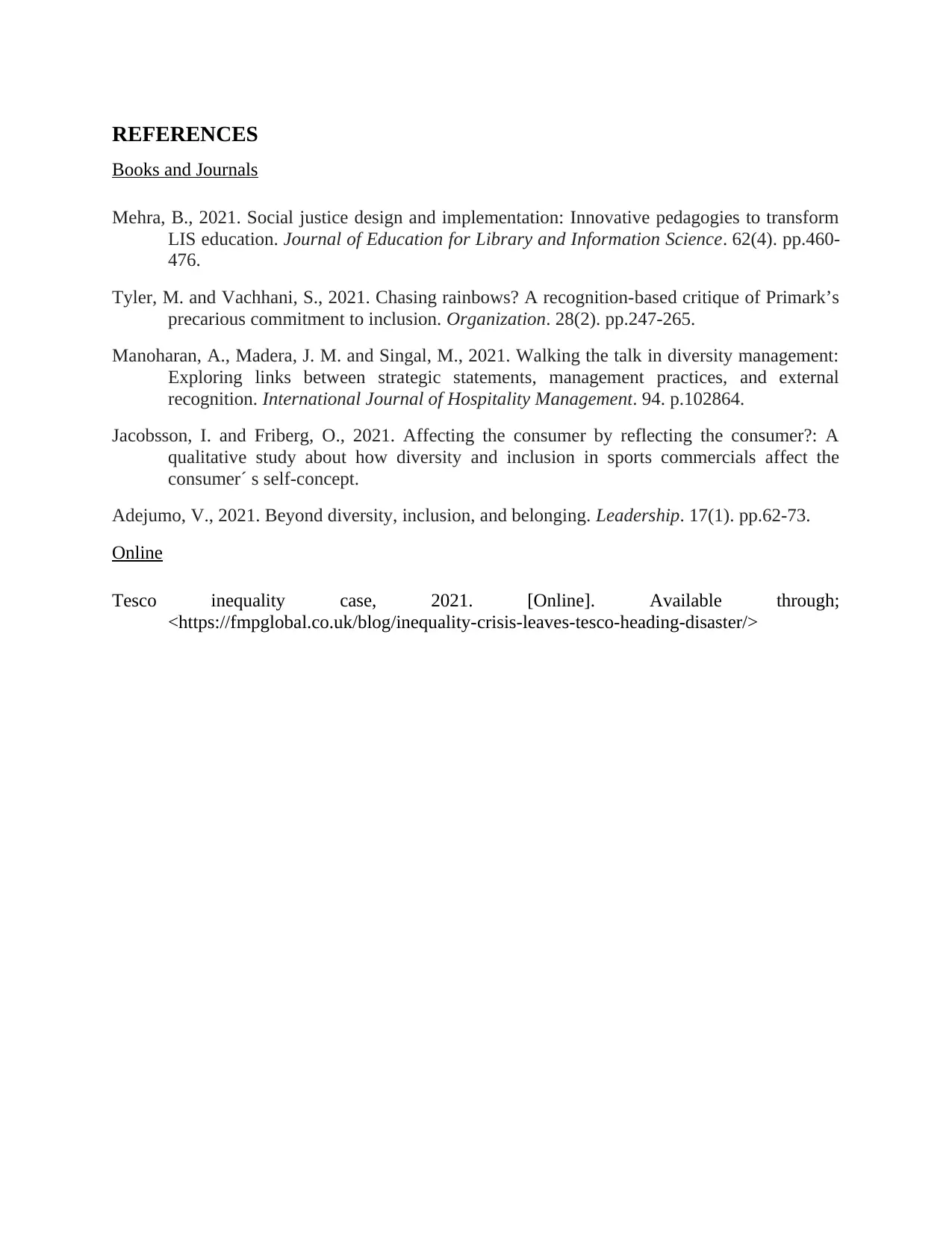
REFERENCES
Books and Journals
Mehra, B., 2021. Social justice design and implementation: Innovative pedagogies to transform
LIS education. Journal of Education for Library and Information Science. 62(4). pp.460-
476.
Tyler, M. and Vachhani, S., 2021. Chasing rainbows? A recognition-based critique of Primark’s
precarious commitment to inclusion. Organization. 28(2). pp.247-265.
Manoharan, A., Madera, J. M. and Singal, M., 2021. Walking the talk in diversity management:
Exploring links between strategic statements, management practices, and external
recognition. International Journal of Hospitality Management. 94. p.102864.
Jacobsson, I. and Friberg, O., 2021. Affecting the consumer by reflecting the consumer?: A
qualitative study about how diversity and inclusion in sports commercials affect the
consumer´ s self-concept.
Adejumo, V., 2021. Beyond diversity, inclusion, and belonging. Leadership. 17(1). pp.62-73.
Online
Tesco inequality case, 2021. [Online]. Available through;
<https://fmpglobal.co.uk/blog/inequality-crisis-leaves-tesco-heading-disaster/>
Books and Journals
Mehra, B., 2021. Social justice design and implementation: Innovative pedagogies to transform
LIS education. Journal of Education for Library and Information Science. 62(4). pp.460-
476.
Tyler, M. and Vachhani, S., 2021. Chasing rainbows? A recognition-based critique of Primark’s
precarious commitment to inclusion. Organization. 28(2). pp.247-265.
Manoharan, A., Madera, J. M. and Singal, M., 2021. Walking the talk in diversity management:
Exploring links between strategic statements, management practices, and external
recognition. International Journal of Hospitality Management. 94. p.102864.
Jacobsson, I. and Friberg, O., 2021. Affecting the consumer by reflecting the consumer?: A
qualitative study about how diversity and inclusion in sports commercials affect the
consumer´ s self-concept.
Adejumo, V., 2021. Beyond diversity, inclusion, and belonging. Leadership. 17(1). pp.62-73.
Online
Tesco inequality case, 2021. [Online]. Available through;
<https://fmpglobal.co.uk/blog/inequality-crisis-leaves-tesco-heading-disaster/>
1 out of 8
Your All-in-One AI-Powered Toolkit for Academic Success.
+13062052269
info@desklib.com
Available 24*7 on WhatsApp / Email
![[object Object]](/_next/static/media/star-bottom.7253800d.svg)
Unlock your academic potential
Copyright © 2020–2025 A2Z Services. All Rights Reserved. Developed and managed by ZUCOL.

